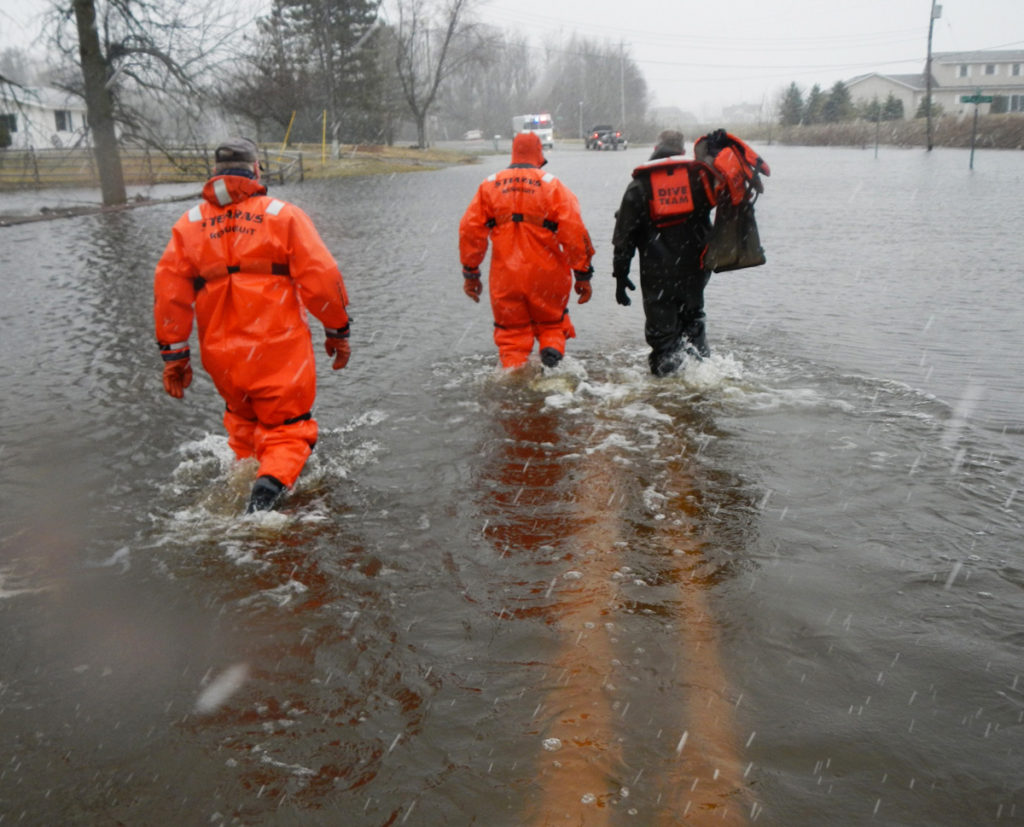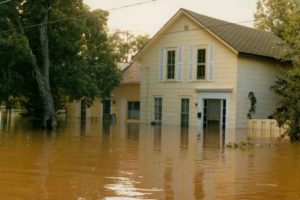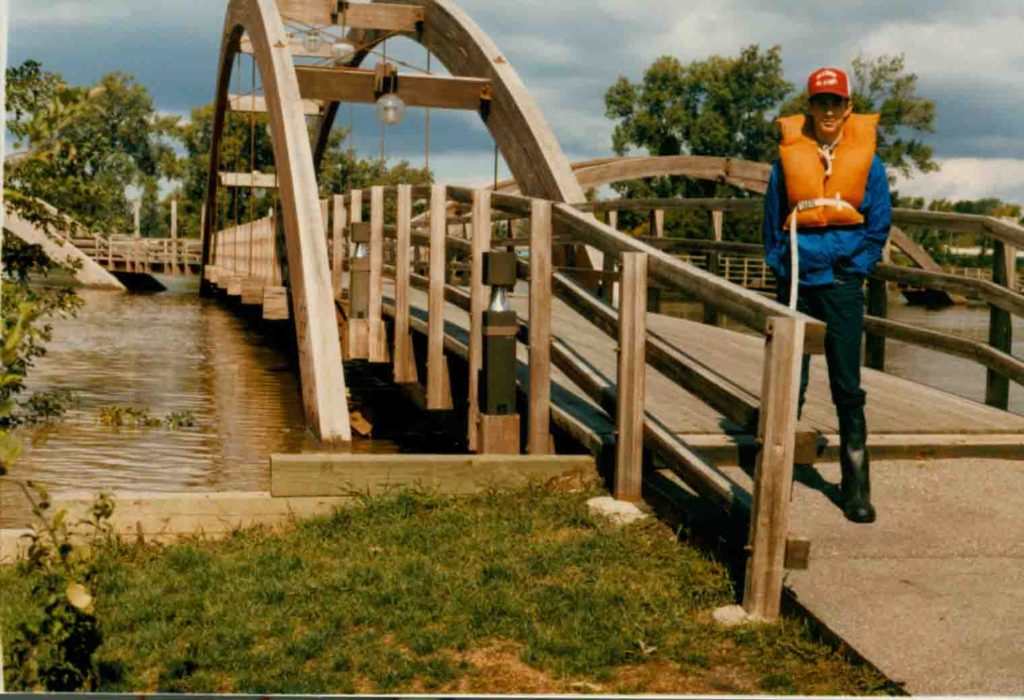The Great Flood of 1986 was not the first major flood to impact the Michigan’s Saginaw Bay region and it won’t be the last. Major improvements have been made in flood forecasting and emergency response practices and technologies over the last thirty years but we will never completely eliminate the risk of flooding. There are some simple and important steps you can take to help your household and community prepare for the next “Great Flood.”
Have a Plan
Flooding can occur during any season in Michigan. Planning in advance can afford you extra critical time when a flood is coming, and can help you increase the odds of protecting your valuable documents, your real estate and your personal property – including cherished belongings. Developing a flood plan is one of the best actions your family, business or community can take to help you respond quickly to a flood. A “rapid-response” plan can be as simple as a one-page plan that answers the following questions:
How will we find out about a coming flood?

The first part of a Flood Plan is putting yourself in a position to get some advance warning of an unfolding situation. Large-scale flooding on the main stem of a river may occur over many hours or several days, but flash floods can strike in minutes. Important steps you can take include signing up for flood alerts and monitoring weather patterns and local conditions. Flooding in Michigan can happen any time of year.
- Sign up for NOAA National Weather Service Flood Alerts at www.focusonfloods.org/flood-alerts
- Monitor river levels from NOAA National Weather Service at: http://water.weather.gov/ahps/region.php?state=mi
- Determine your property’s proximity to waterways by learning about and reviewing flood hazard maps at: https://www.floodsmart.gov/why/all-about-flood-maps
At what river level does our property begin to flood?
First, determine “What’s Your Number?” by learning the flood stage at the stream gage nearest you. This information is available through the National Weather Service’s Advanced Hydrologic Prediction Services web site at http://water.weather.gov/ahps. Then, determine the level at which floodwaters begin to affect your property. This step may take research or personal experience to determine, such as talking to neighbors to find out how high the river was during recent floods, and at what point flooding began in your neighborhood. Each neighborhood and each property has its own unique terrain and placement to consider when determining this factor, and it is safest to err on the side of caution.
How will we learn about evacuation orders?
Contact your local emergency management office to find out how your community notifies residents of floods and how it will issue evacuation orders. Make a commitment to follow evacuation orders the first time to help prevent emergency personnel from having to return to the affected area for a rescue when travel is no longer safe.
What access roads can we use to evacuate in the case of rising waters?
The majority of flood related deaths occur when cars become trapped on roads that are known to flood. To prevent this, follow instructions from emergency personnel and before a flood happens talk to neighbors, emergency personnel and others to determine when and where flooding typically occurs on access roads leading to your home. Know what roads you regularly travel and whether or not they will flood, and plan alternate routes when needed. Never attempt to cross a flooded road.
What steps should we take to prepare our property?
Research the flood-proofing options available to you. Can you install a quick-disconnect furnace, or elevate electrical and mechanical equipment? Are there steps you can take to alleviate pressure on your structure and to prevent extensive damage to doors and windows if flooding does occur? For additional information about protecting your property from floods, visit www.mcswa.com.

Flooded home during the 1986 flood. Photo credit: Midland County Historical Society
Where should our family meet if we are separated during a flood event?
Before a flood or other emergency strikes, designate a safe place away from your home where your family members can all meet. Make sure that all family members know the location and you have a plan for contacting each. Remember cell phone service and electrical utilities may be impacted by flooding. In addition, it is important to know whether your child’s school or family members’ work place is in a flood zone. If so, what provisions are in place to ensure their safety? You can find templates for family communication plans here https://www.fema.gov/media-library/assets/documents/34330
Other Considerations:
- A written plan is essential for helping individuals and household members to think through important issues in advance. You should also research whether there are similar plans in place for your work and children’s daycare and school, as well as to see how they work with your plan.
- Expect roadways to be blocked during a flood. Contact your friends and family to ensure they are safely sheltered. Listen to local media for flood-prone roads as well as making contact with neighbors in your area.
- Remember, the most common things people regret planning to protect during an emergency include pets, photographs and computers. Can you pack all these in a vehicle and drive to higher ground in time? Ensure you have a plan in place to protect your pets and keepsakes before an emergency.
Build a Kit
Building an emergency management kit will help prepare your household for many different types of disasters not just floods. Your emergency kit should include first aid supplies, a three-day supply of non-perishable food, bottled water, a battery-powered radio, flashlights and extra batteries. Also, have personal items ready such as rubber boots, a rain jacket, warm clothes, medications, and hygiene products. You can find a complete checklist for what to include in your emergency kit here http://www.fema.gov/media-library-data/1390846764394-dc08e309debe561d866b05ac84daf1ee/checklist_2014.pdf
Learn the Lingo
Flood Watch: Flooding is possible. Tune in to your NOAA Weather Radio, local radio or television for information and check the flood alert sites on the internet.
Flash Flood Watch: Flash flooding is possible. Be prepared to move to higher ground and tune in to your NOAA Weather Radio, commercial radio or television for information.
Flood Warning: Flooding is occurring or will occur soon. If advised to evacuate, do so immediately.

Midland County Historical Society
Flash Flood Warning: A flash flood is occurring. Seek higher ground immediately.
Explore the Resources
Michigan Committee for Severe Weather Awareness www.mcswa.com
Red Cross http://www.redcross.org/get-help/prepare-for-emergencies/types-of-emergencies/flood#/Prepare
National Flood Insurance Program https://www.floodsmart.gov
National Weather Service https://www.weather.gov/wrn/spring2017-flood-sm
Department of Homeland Security https://www.ready.gov/floods
The information on this page was prepared by the Michigan Committee for Severe Weather Awareness (MCSWA), a coalition formed to promote safety awareness and coordinate public information efforts regarding tornadoes, flooding, lightning and winter weather. Learn more at http://media.wix.com/ugd/6e3595_b61c1514120d4e5c8b67c361dd3b3e38.pdf
Additional resources:
Canadian resource: https://calgary.com/home-flood-safety-guide.php
National Council for Home Safety and Security: Complete Guide to Flood Safety and Preparedness